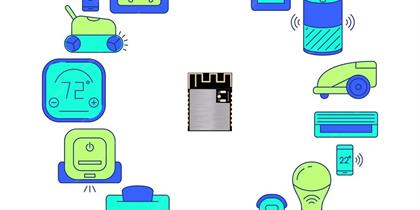
 In the intricate world of Bluetooth Low Energy (BLE) communications, the Generic Attribute Profile (GATT) plays a pivotal role in defining the structure and methods for data exchange. Central to this are the processes of Notifications and Indications, which are the primary means by which GATT servers update clients about changes in attribute values. This article delves into the subtleties and significance of these mechanisms, highlighting their roles in the efficient operation of BLE systems.
In the intricate world of Bluetooth Low Energy (BLE) communications, the Generic Attribute Profile (GATT) plays a pivotal role in defining the structure and methods for data exchange. Central to this are the processes of Notifications and Indications, which are the primary means by which GATT servers update clients about changes in attribute values. This article delves into the subtleties and significance of these mechanisms, highlighting their roles in the efficient operation of BLE systems.
Understanding Notifications and Indications
At the core of BLE GATT operations are characteristics, which are the fundamental data elements that can be read or written. These characteristics can notify or indicate changes to connected clients. The distinction between these two lies in the nature of the communication and the level of reliability they offer.
- Notifications: A notification is a one-way communication from a GATT server to a client. It does not require an acknowledgment from the client. This makes notifications a faster method of data transmission but with less reliability. If a client does not read the data quickly enough, it may be overwritten by subsequent notifications.
- Indications: Indications, on the other hand, are also sent from a GATT server to a client, but they require an acknowledgment from the client. This confirmation ensures that the data has been received and processed, making indications a more reliable form of communication.
The Role of Client Characteristic Configuration Descriptor (CCCD)
Both notifications and indications are controlled by the CCCD, a special descriptor that determines how updates are sent from the GATT server to the client. The client must write to this descriptor to enable notifications or indications for a particular characteristic.
Data Reliability and Throughput
The choice between using notifications or indications often comes down to the required level of data reliability. Indications, while more reliable due to the acknowledgment requirement, can lead to lower throughput because the server must wait for a response before sending the next indication.
Notifications, not requiring acknowledgments, allow for a higher data throughput but at the risk of data loss if the client cannot read the data quickly enough. This makes notifications suitable for applications where data loss is acceptable and a higher data rate is preferred.
Implementation Considerations
Implementing notifications and indications involves several steps:
- Service and Characteristic Definition: The GATT server defines the services and characteristics, including which characteristics will support notifications or indications.
- CCCD Configuration: The client must configure the CCCD to enable the desired update mechanism. This configuration is crucial as it determines the client’s interest in receiving updates.
- Data Transmission: Once enabled, the GATT server can send notifications or indications. The client must be prepared to handle these updates, reading the data promptly to avoid loss in the case of notifications.
- Handling Responses: For indications, the client must send a response back to the server to acknowledge receipt. This response is vital for the server to know that it can proceed with subsequent updates.
Conclusion
Notifications and indications are powerful tools in the BLE GATT arsenal, offering developers a choice between speed and reliability based on the application’s needs. As BLE technology continues to evolve, the efficient use of these mechanisms will remain critical in ensuring that BLE devices operate effectively and meet user expectations. Whether it’s a fitness tracker updating a smartphone with the latest workout data or a smart home device signaling a change in state, the dynamics of BLE GATT notifications and indications underpin the seamless operation of these interactions.
You Might Like Also

In the quest for cleaner and healthier indoor air, Bluetooth modules have become an integral part of modern air purifiers. These compact devices enable wireless communication between the air purifier and other systems, such as smartphones or home automation networks. By integrating Bluetooth technology, air purifiers can offer a range of advanced f Read More

In the modern landscape of wireless technology, Bluetooth modules have become indispensable components, enabling a myriad of applications that enhance our daily lives. These compact devices, embedded within a wide array of products, facilitate communication and connectivity with minimal effort. This article delves into the diverse applications of B Read More

The Versatility of Bluetooth Modules: Unleashing Connectivity
In the realm of wireless communication, Bluetooth modules have emerged as the Swiss Army knife of connectivity, enabling seamless interaction between devices over short distances. These compact devices have become indispensable in a variety of applications, from consumer electronics to industrial automation. Bluetooth modules are the silent workhor Read More

Enriching the Museum Experience: The Role of Bluetooth Beacons
Bluetooth Beacons are wireless transmitters that can detect the presence of mobile devices within their vicinity. In a museum setting, beacons can be placed at various exhibits to provide a wealth of information and interactive content to visitors. As a visitor approaches an exhibit, their device can receive a signal from the beacon, triggering an Read More

Bluetooth beacon used in Indoor Positioning Systems
Bluetooth beacons have become an essential component in Indoor Positioning Systems (IPS), providing accurate location data that enhances various applications within controlled environments. In smart retail settings, beacons play a crucial role in enhancing customer experiences, optimizing store operations, and driving business insights. Read More

The role of Bluetooth beacons in RTLS
Bluetooth beacons are playing an increasingly vital role in Real-Time Locating Systems (RTLS), particularly within the context of warehouse management. These tiny, yet powerful devices, are redefining the way warehouses operate, offering a new level of efficiency and precision that is transforming inventory tracking and asset management. Read More











